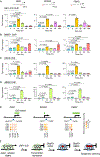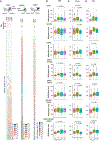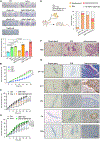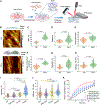PAI-1 uncouples integrin-β1 from restrain by membrane-bound β-catenin to promote collagen fibril remodeling in obesity-related neoplasms
- PMID: 39046873
- PMCID: PMC11956528
- DOI: 10.1016/j.celrep.2024.114527
PAI-1 uncouples integrin-β1 from restrain by membrane-bound β-catenin to promote collagen fibril remodeling in obesity-related neoplasms
Abstract
The paracrine actions of adipokine plasminogen activator inhibitor-1 (PAI-1) are implicated in obesity-associated tumorigenesis. Here, we show that PAI-1 mediates extracellular matrix (ECM) signaling via epigenetic repression of DKK1 in endometrial epithelial cells (EECs). While the loss of DKK1 is known to increase β-catenin accumulation for WNT signaling activation, this epigenetic repression causes β-catenin release from transmembrane integrins. Furthermore, PAI-1 elicits the disengagement of TIMP2 and SPARC from integrin-β1 on the cell surface, lifting an integrin-β1-ECM signaling constraint. The heightened interaction of integrin-β1 with type 1 collagen (COL1) remodels extracellular fibrillar structures in the ECM. Consequently, the enhanced nanomechanical stiffness of this microenvironment is conducive to EEC motility and neoplastic transformation. The formation of extensively branched COL1 fibrils is also observed in endometrial tumors of patients with obesity. The findings highlight PAI-1 as a contributor to enhanced integrin-COL1 engagement and extensive ECM remodeling during obesity-associated neoplastic development.
Keywords: CP: Cancer; CP: Metabolism; DKK1; ECM remodeling; PAI-1; collagen fibrils; endometrial cancer; integrin inside-out signaling; obesity.
Copyright © 2024 The Authors. Published by Elsevier Inc. All rights reserved.
Conflict of interest statement
Declaration of interests The authors declare no competing interests.
Figures







References
-
- Polusani SR, Huang YW, Huang G, Chen CW, Wang CM, Lin LL, Osmulski P, Lucio ND, Liu L, Hsu YT, et al. (2019). Adipokines deregulate cellular communication via epigenetic repression of gap junction loci in obese endometrial cancer. Cancer Res. 79, 196–208. 10.1158/0008-5472.CAN-18-1615. - DOI - PMC - PubMed
Publication types
MeSH terms
Substances
Grants and funding
LinkOut - more resources
Full Text Sources
Medical
Miscellaneous

